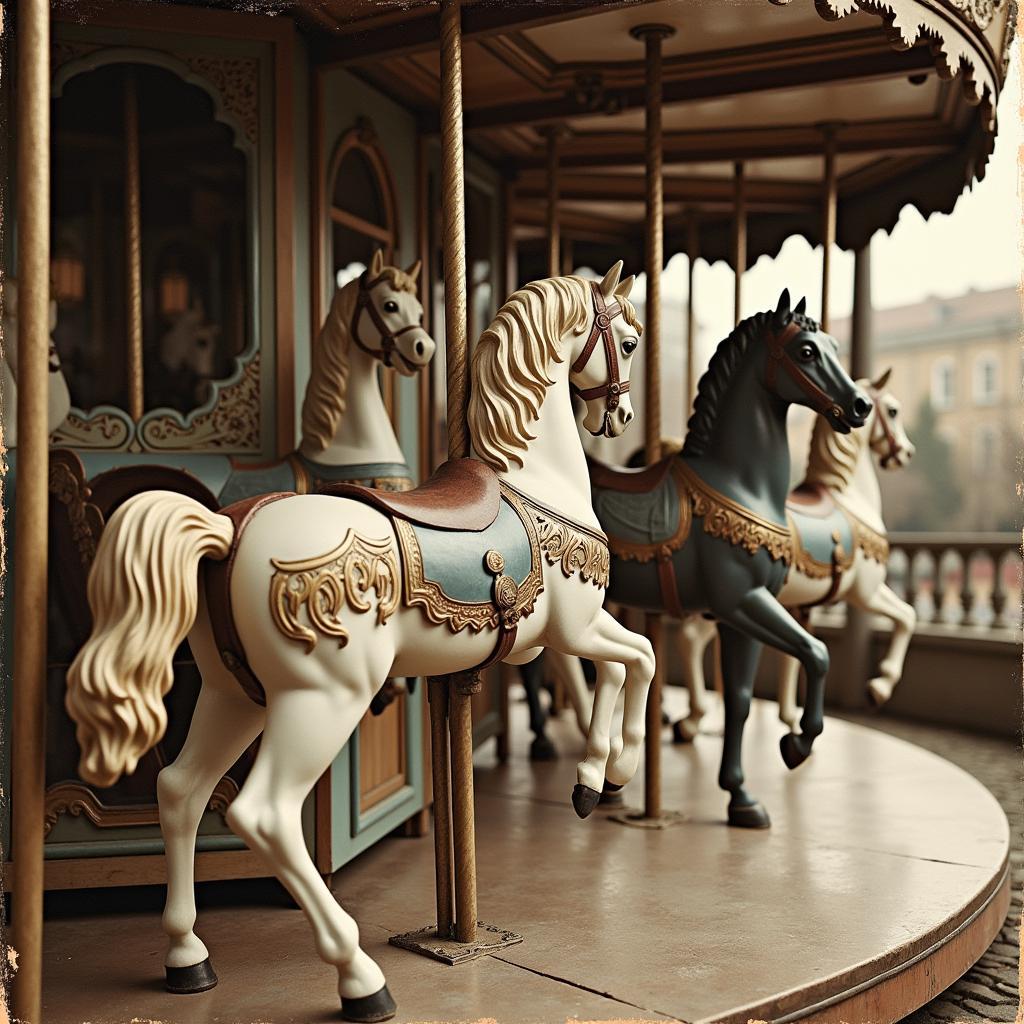Carousel Horse Carvings evoke a sense of nostalgia, transporting us back to childhood memories of amusement parks and fairgrounds. But these intricate figures are much more than just amusement ride decorations; they’re exquisite works of art, each with its own unique history and craftsmanship. Whether you’re an art enthusiast, an antique collector, or simply captivated by the magic of carousels, delve into the captivating world of carousel horse carving.
A Gallop Through History: The Origins of Carousel Horse Carvings
The roots of carousel horse carvings intertwine with the evolution of the carousel itself. Early carousels, dating back to the 12th century, were far from the whimsical rides we know today. Instead, they served as training devices for knights, featuring wooden horses suspended from a central pole.
Fast forward to the 18th and 19th centuries, and carousels evolved into a popular form of entertainment across Europe and America. Skilled artisans, primarily in England, France, Germany, and the United States, began crafting increasingly elaborate and decorative horses for these merry-go-rounds.
 European Carousel Horses
European Carousel Horses
The Art of Carousel Carving: From Wood to Wonder
Creating a carousel horse carving is a labor of love, demanding both artistic vision and technical mastery. Here’s a glimpse into the intricate process:
-
Designing and Selecting Wood: The journey begins with a design, often inspired by real horse breeds or fantastical creatures. Artisans meticulously choose durable woods like basswood, poplar, or pine for their carvability.
-
Roughing Out: Using patterns and band saws, the wood is shaped into the basic form of the horse.
-
Carving the Details: This stage is where the true artistry shines. Master carvers use chisels, gouges, and other hand tools to create the horse’s musculature, mane, tail, and intricate details.
-
Sanding and Priming: After carving, the horse is meticulously sanded to a smooth finish, preparing it for painting.
-
Painting and Finishing: Carousel horses are renowned for their vibrant colors and elaborate designs. Artists employ various painting techniques, often using multiple layers and finishes to achieve a luminous effect.
 Carousel Horse Painting Process
Carousel Horse Painting Process
Types of Carousel Horse Carvings: A Menagerie of Styles
Over the decades, distinct styles of carousel horse carving emerged, each bearing the signature of their creators and geographic origins. Let’s explore some of the most notable styles:
-
Philadelphia Style: Known for their dynamic poses, flowing manes, and jewel-toned decorations.
-
Coney Island Style: Characterized by flamboyant and realistic horses, often featuring dramatic expressions and elaborate accessories.
-
Country Fair Style: Simpler and more stylized compared to their urban counterparts, often showcasing folk art influences and bright, primary colors.
Do you adore the classic elegance of antique wood horse carvings? You can discover more about these timeless pieces on Justus Horses USA.
Carousel Horse Carvings Today: Preserving a Legacy
While the golden age of carousel building may be behind us, the allure of carousel horse carvings remains as strong as ever. Today, these captivating figures are cherished as:
-
Collectibles: Antique carousel horses, especially those by renowned carvers, are highly sought after by collectors, fetching impressive prices at auctions.
-
Decorative Art: Vintage and reproduction carousel horses add a touch of whimsy and nostalgia to homes, businesses, and event spaces.
-
Symbols of Joy and Wonder: Carousel horse carvings continue to spark joy and wonder in people of all ages, reminding us of the simple pleasures of childhood.
If you’re interested in exploring modern interpretations, you can find beautifully crafted fiberglass carousel horses on Justus Horses USA.
FAQs About Carousel Horse Carvings
1. What are carousel horses made of?
Traditionally, carousel horses were carved from wood, typically basswood, poplar, or pine. Today, you can also find carousel horses made from materials like fiberglass and resin.
2. How can I tell if a carousel horse is antique?
Antique carousel horses often exhibit signs of age, such as paint craquelure, wear patterns, and repairs. However, it’s best to consult with an expert to authenticate an antique carousel horse.
3. Are carousel horses still made today?
Yes, while mass production of carousel horses declined after the mid-20th century, there are still skilled artisans and companies crafting beautiful carousel horses today. Some specialize in recreating antique styles, while others offer contemporary interpretations.
Seeking an Unpainted Canvas?
Looking for an unpainted carousel horse to unleash your creativity? Justus Horses USA offers a range of unpainted carousel horses, perfect for artists, hobbyists, and anyone who wants to add their personal touch to these magnificent figures.
Beyond the Carousel: Explore More Equestrian Art
From life-size sculptures to miniature figurines, the world of equestrian art extends far beyond the carousel. To learn more about different forms of horse-inspired art and craftsmanship, explore our other articles on Justus Horses USA, your trusted source for all things equine.
Need Help?
For any inquiries or assistance with our products or services, feel free to contact us. Call us at 0772127271, email us at [email protected], or visit our location at QGM2+WX2, Vị Trung, Vị Thuỷ, Hậu Giang, Việt Nam. Our dedicated customer support team is available 24/7 to assist you.